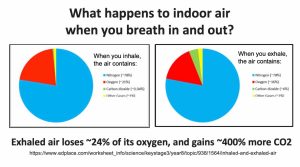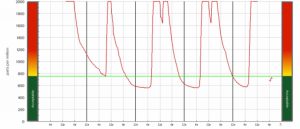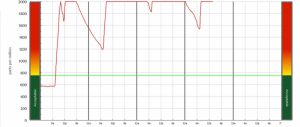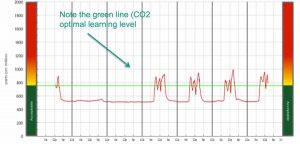Posted by: Francis Koster Published: January 30, 2024
A Second Lesson on Lack of Fresh Air in Classrooms (January 30, 2024)
Issue #9
A second lesson on how lack of fresh air in classrooms lowers learning dramatically.
We have been surveying hundreds of North Carolina classrooms since 2017, and uncovered some astonishing information.
Before sharing our results, I thought it might be helpful to remind you of this graph from last week's newsletter. It explains what happens when a room full of students breaths air in and out all day long. If you take one minute to review this, it will make the subsequent graphs easier to understand. When each student inhales, they bring into their lungs around 21% oxygen (O2), and 0.04% carbon dioxide (CO2). When they exhale, the used air contains 100 times more carbon dioxide - 4%, while the amount of oxygen is reduce to 16%.(1) And this goes on repeatedly all day long, compounding both effects.
When each student inhales, they bring into their lungs around 21% oxygen (O2), and 0.04% carbon dioxide (CO2). When they exhale, the used air contains 100 times more carbon dioxide - 4%, while the amount of oxygen is reduce to 16%.(1) And this goes on repeatedly all day long, compounding both effects.
Multiple scientific studies show that high CO2 levels indicate poor air quality that can slow students' (and teacher's) brain activity unless additional fresh air is introduced. (2)
CO2 is a very useful indicator of indoor air quality. The meter counts parts per million (PPM) of CO2 in the air.
Since beginning our work in 2017, we have learned that only about half of all North Carolina classrooms have air quality good enough to permit reasonable mental functioning and learning. According to ASHREA, (the global entity which sets engineering standards), the desirable level of CO2 INHALED air averaged over the 8 hours in the classroom is between 800 and 1,000 PPM (the green line you see in the graph (3).
Only about half of all classrooms we surveyed hit this target.
The chart below shows one of the 50% of classrooms that does. (Note the hours of occupancy at the bottom of the graph)
However, around 50% of all classrooms miss that target. 40% of all classrooms we surveyed look similar to this graph below. Note that these levels are present when the classroom is occupied. This level of CO2 lowers learning one letter grade--and seriously compromises the chance for a college admission and/or scholarship.
(The flat line at the top is the highest our meters can measure - if you see a flat line, the CO2 level is more than 2,000)
And for 10% of all classrooms we surveyed we found so much CO2 that learning is lowered two letter grades--contributing to a higher drop out rate for many already challenged students.
In the 1/2 of all North Carolina classrooms that have poor Indoor Air Quality, the teacher will probably be criticized for poor performance.
How did this situation arise? There are two main causes:
1) There are two basic kinds of air conditioning systems. Old ones only raise or lower temperature and (sometimes) humidity. Newer systems bring in outside air and mix it with the existing air to freshen it up as well as change the temperature. When energy costs started to rise rapidly in the 1970's, in places where newer systems were installed, facilities management staff around the world began to lock windows, seal doors, and lower the amount of fresh air intake. The total result of all this energy conservation effort was that the quality of the indoor air (as indicated by rising CO2 levels) went down.
2) In some states, construction and building maintenance costs are paid for by the state, and distributed equally on a per student basis just like instruction costs. In other states, like North Carolina, and unlike instruction costs, building construction and maintenance are largely the responsibility of the local school district.
In North Carolina, lower-than-average-income school districts results in lower school's facilities budgets, lower indoor air quality, lower learning, and lower property values.
Through no fault of the teachers or the students, the school system's success rate declines because of poor indoor air quality.
High income school districts mean higher real estate property values, which results in higher school system budgets, and subsequently results in still higher school construction and maintenance budgets, better indoor air quality and higher standardized test scores. And teachers with good reputations.
If you really want do dig into this topic, this article published in The Journalists Resource, published by the Harvard Kennedy School, contains a great summary of all the ways lack of fresh air impacts students and teachers. (5)
Lower learning due to poor indoor air quality has nothing to do with how well teachers are doing their job.
-----------------------------------------------------------------------------------------
O.K. Educators ----- Want to survey your classrooms for Indoor Air Quality?
Our partner organization, The Pollution Detectives, Inc. (a North Carolina 501-c-3), will loan you (for free) simple-to-use CO2 meters that you can quickly install and place yourself to do your own Indoor Air Quality survey. The meter sends its data to us, and we send the report back to you. We sign confidentiality agreements before you begin to use the meters, and will be legally bound to not share your information with anyone.
If you are interested in exploring this possibility, go to www.thepollutiondetectives.org, and read the material in the menu on your left, "Is your school’s indoor air quality lowering learning?"
Click here to file a form to borrow equipment.
In spite of the hard work of all our educators, North Carolina K-12 public Schools rank very near the bottom of all 50 states (4)--in large part due to learning environments that badly need improving.
If we are to improve our schools, we need to 'make the invisible visible'.
-----------------------------------------------------------------------------------------
Regarding hearing and vision surveys
We are hitting the "pause" button.
We have learned from some of our Newsletter readers that while they are very interested in the possibility of large-scale surveying of their student populations for vision or hearing issues, the recent action by the North Carolina state legislature on the "Parents Bill Of Rights" law has created local confusion about emerging regulations.
As a consequence, we will pause our efforts to connect with school systems with whom we might have partnered to perform such surveys. We will reach out again when the fog has lifted.
If any of you are still interested, please reach out to us at info@theoptimisticfuturist.org.
-----------------------------------------------------------------------------------------
We are trying to grow the number of School Nurses who get our newsletters. If you know of such a talented person, click here to: Subscribe a Friend!
------------------------------------------------------------------------------------------
FOOTNOTES
- https://www.edplace.com/worksheet_info/science/keystage3/year8/topic/938/1564/inhaled-and-exhaled-air
- http://thepollutiondetectives.org/wp-content/uploads/2023/11/TPD-11212023-IAQ-Menu-Bibliography-on-Indoor-Air-Quality.pdf
- https://www.co2meter.com/blogs/news/ashrae-co2-standards-classrooms
- https://ballotpedia.org/Public_education_in_North_Carolina#:~:text=In%202022%2C%20North%20Carolina%20had,schools%20in%20120%20school%20districts.
- https://journalistsresource.org/education/indoor-air-quality-schools-student-learning-health/
Copyright © 2020 The Optimistic Futurist. All Rights Reserved.
Francis P. Koster Ed.D.
Proven local solutions to national problems.
CONTACT
Copyright © 2023 America's Optimistic Futurist
